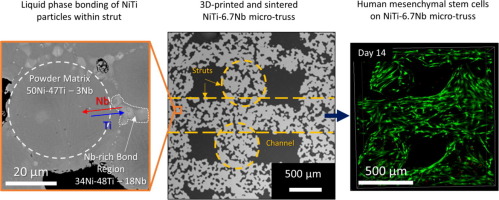Acta Biomaterialia ( IF 9.4 ) Pub Date : 2018-06-15 , DOI: 10.1016/j.actbio.2018.06.015 Shannon L. Taylor , Amaka J. Ibeh , Adam E. Jakus , Ramille N. Shah , David C. Dunand

|
We present a novel additive manufacturing method for NiTi-Nb micro-trusses combining (i) extrusion-based 3D-printing of liquid inks containing NiTi and Nb powders, solvents, and a polymer binder into micro-trusses with 0/90° ABAB layers of parallel, ∼600 µm struts spaced 1 mm apart and (ii) subsequent heat-treatment to remove the binder and solvents, and then bond the NiTi powders using liquid phase sintering via the formation of a transient NiTi-Nb eutectic phase. We investigate the effects of Nb concentration (0, 1.5, 3.1, 6.7 at.% Nb) on the porosity, microstructure, and phase transformations of the printed NiTi-Nb micro-trusses. Micro-trusses with the highest Nb content exhibit long channels (from 3D-printing) and struts with smaller interconnected porosity (from partial sintering), resulting in overall porosity of ∼75% and low compressive stiffnesses of 1-1.6 GPa, similar to those of trabecular bone and in agreement with analytical and finite element modeling predictions. Diffusion of Nb into the NiTi particles from the bond regions results in a Ni-rich composition as the Nb replaces Ti atoms, leading to decreased martensite/austenite transformation temperatures. Adult human mesenchymal stem cells seeded on these micro-trusses showed excellent viability, proliferation, and extracellular matrix deposition over 14 days in culture.
Statement of Significance
Near-equiatomic NiTi micro-trusses are attractive for biomedical applications such as stents, actuators and bone implants because of their combination of biocompatibility, low compressive stiffness, high surface area, and shape-memory or superelasticity. Extrusion-based 3D-printing of NiTi powder-based inks into micro-trusses is feasible, but the subsequent sintering of the powders into dense struts is unachievable due to low diffusivity, large particle size, and low packing density of the NiTi powders. We present a solution, whereby Nb powders are added to the NiTi inks, thus forming during sintering a eutectic NiTi-Nb liquid phase which bonds the solid NiTi powders and improves densification of the struts. This study investigates the microstructure, porosity, phase transformation behavior, compressive stiffness, and cytocompatibility of these printed NiTi-Nb micro-trusses.
中文翻译:

通过粉末的基于挤压的3D打印和瞬态液相烧结制造的NiTi-Nb微桁架
我们提出了一种用于NiTi-Nb微桁架的新型增材制造方法,该方法将(i)包含NiTi和Nb粉末,溶剂和聚合物粘合剂的液态油墨的基于挤压的3D打印结合成具有0/90°ABAB层的微桁架平行地,约600 µm的撑杆相距1 mm,并且(ii)随后进行热处理以去除粘合剂和溶剂,然后使用液相烧结通过形成瞬态NiTi-Nb共晶相来粘结NiTi粉末。我们调查了Nb浓度(0、1.5、3.1、6.7 at。%Nb)对印刷NiTi-Nb微桁架的孔隙率,微结构和相变的影响。Nb含量最高的微桁架具有较长的通道(来自3D打印)和具有较小的互连孔隙率的支柱(来自部分烧结),导致整体孔隙率约为75%,抗压刚度低至1-1.6 GPa,与小梁骨相似,并且与分析和有限元建模预测相符。Nb从键合区域扩散到NiTi颗粒中会形成富Ni的成分,因为Nb会取代Ti原子,从而导致马氏体/奥氏体相变温度降低。播种在这些微桁架上的成年人间充质干细胞在培养的14天中表现出出色的生存力,增殖能力和细胞外基质沉积。导致马氏体/奥氏体相变温度降低。播种在这些微桁架上的成年人间充质干细胞在培养的14天中表现出出色的生存力,增殖能力和细胞外基质沉积。导致马氏体/奥氏体相变温度降低。播种在这些微桁架上的成年人间充质干细胞在培养的14天中表现出出色的生存力,增殖能力和细胞外基质沉积。
重要声明
几乎等原子的NiTi微桁架因其生物相容性,低压缩刚度,高表面积以及形状记忆或超弹性的组合而吸引了生物医学应用,例如支架,致动器和骨植入物。将基于NiTi粉末的油墨进行基于挤出的3D打印到微桁架中是可行的,但是由于NiTi粉末的低扩散性,大粒径和低堆积密度,因此无法将粉末随后烧结成致密的支柱。我们提出了一种解决方案,其中将Nb粉末添加到NiTi油墨中,从而在烧结过程中形成共晶NiTi-Nb液相,该液相与固体NiTi粉末结合并改善了支杆的致密性。这项研究调查了微观结构,孔隙率,相变行为,抗压刚度,











































 京公网安备 11010802027423号
京公网安备 11010802027423号